Once upon a time, before vegetable oils and when olive oil was rare in the US, pork was raised mainly for its fat. Almost every rural household kept a couple of pigs fattening up for the winter. This is where we get the image of a fat old pig rolling in the mud and eating slop. For many of us the image remains, but it could not be further from the truth!
Today healthy olive and vegetable oils are common and consumers are much more fat and health conscious. We want lean meats that are mild and tender, and raised in a sustainable and humane manner – so the way hogs are raised has changed dramatically! Thanks to carefully planned diets (rather than ‘slopping the hogs’) and a variety of humane raising strategies, today’s pork is like a whole new animal!
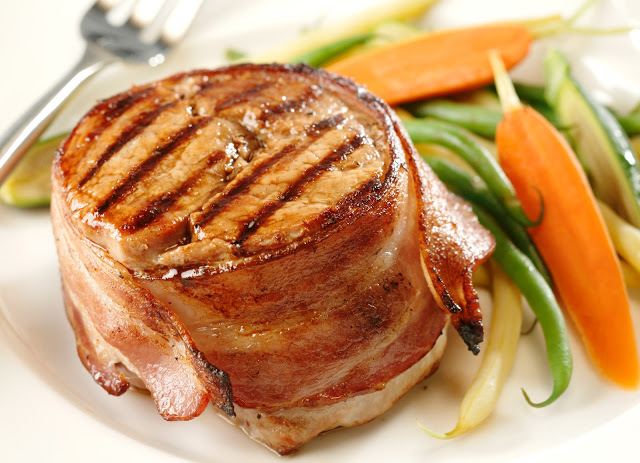
Bacon-wrapped pork tenderloin
77% Less Fat
In 1963 a broiled 3-ounce serving of pork packed 29.6 gr of fat and 351 calories. Today the same 3-ounce serving has only 6.9 gr of fat and 165 calories – a fat reduction of 77%!
The data gets even better with pork’s leanest and most tender cut, the tenderloin. A roasted 3-ounce serving has only 133 calories, 67 mg. cholesterol and 4.1 gr. fat, comparable to roasted skinless chicken breast (139 calories, 71 mg. cholesterol and 3 gr. fat).
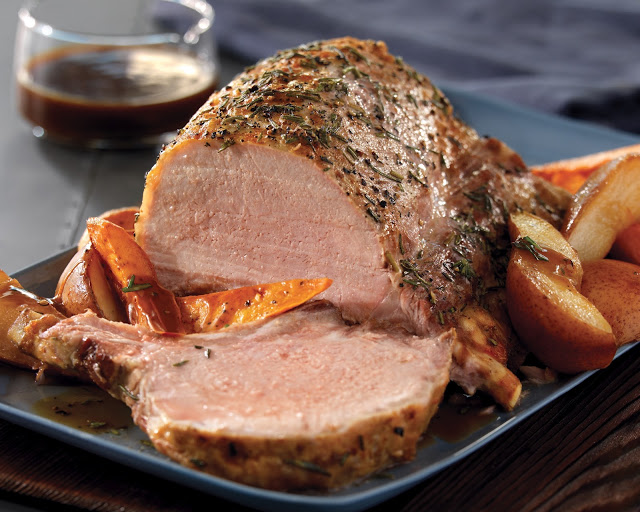
Pork Loin Roast with sweet potato, pears and rosemary.
Bye-Bye Trichinosis
Trichinosis used to be a concern in pork. However, thanks to modern feed blends, its occurrence is virtually non-existent in quality pork. Infections these days are almost always associated with eating wild game such as wild boar, bear and cougar.
Even if Trichinella was present, it’s killed by cooking above 137° F. Back when trichinosis was common, pork was very high in fat, and meat thermometers weren’t very accurate. So health officials erred on the side of safety and recommended cooking above 170°. However, today’s pork is much leaner and safer, so recommended cooking temperatures have been reduced.
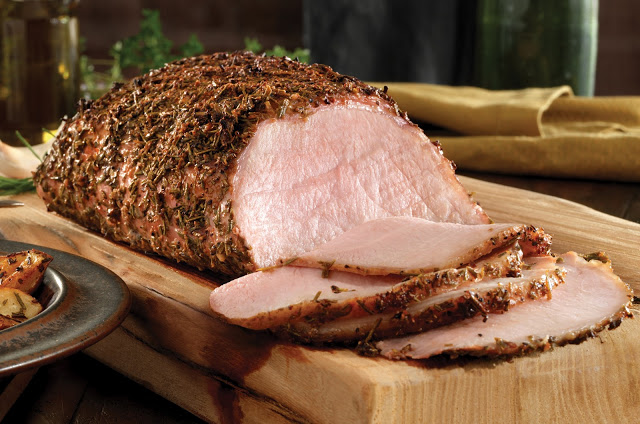
A perfectly cooked Balsamic Rosemary Loin Roast.
Cooking Pork
First, throw out that old mindset of cooking it a little extra “just to be safe”, or as my mom used to say, “until it’s done, done DONE!” While this was prudent in the past, it’s wrong today.
Today’s pork is very lean, and lean meats cook much faster than fatty meats, so short cooking times are the new rule. Cook pork chops and roasts to 145° F. followed by a 3 minute resting time, they turn out juicy, flavorful and just a little bit pink inside (don’t fear the pink, it’s perfect!). More details follow.
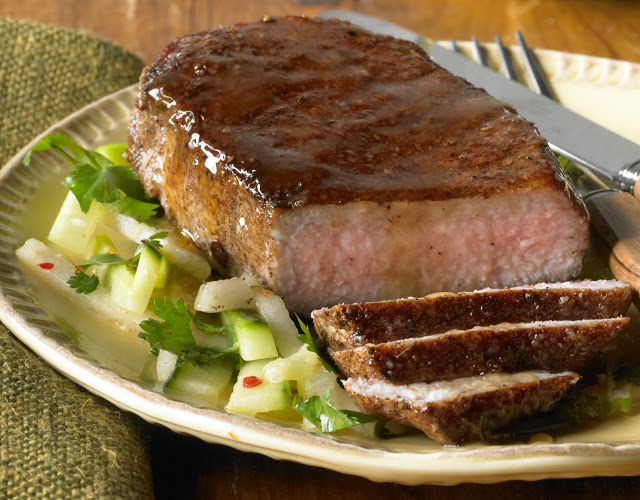
Chinese Five Spice and Maple Glazed Chop. Note the blush color, it’s perfect!
Pork Loin and Leg:
This is where the chops and leanest roasts come from, the loin is comparable to the NY Strip and Rib of beef and the leg compares to lean top round roasts. These cuts are best cooked to 145° internal.
- Pork Chops: Thin pork chops on the grill, under the broiler or in the pan will generally cook in about 6-9 minutes. Thicker chops in roughly 12-16 minutes and tenderloin in about 20-25 minutes. Of course conditions vary, so a meat thermometer is recommended. Once remove from heat, tent with foil and rest for 5-10 minutes before serving.Find Pork Chops at your local market!
- Pork Roasts: Cook most roasts at 350°, allowing about 20 minutes per pound for loin, 12 min/LB for crown, 15 mins/LB for Leg/Fresh Ham. I suggest grilling or roasting Pork Tenderloin at 425° for about 20-25 minutes total time. Cover and rest at least 10 minutes. Find Pork Roasts at your local market!

Cuban Pork Tenderloin – once again perfectly cooked!
Ribs and Shoulders:
These cuts are hard working muscles that need longer cooking time to get nice and tender. I recommend braising, or cooking covered with liquid until they are pull-apart tender, or slow smoking.
- Spare Ribs, Back Ribs and Country Ribs: Place in a roasting pan, add water to at least 1 inch deep, place ribs on a rack (optional), cover tightly and braise in a 325° oven for 60-120 minutes. Test by pulling on a bone for your desired level of tenderness, from a little chewy to falling off the bone.
- Pork Shoulders: Braise or slow smoke pork shoulders/butts for at least 6 hours until it’s falling apart tender.
Ground Pork:
Like all ground meats, should still be cooked to 160° internal for safety and the best taste.
Additives In Pork?
We have and will never sell pork with additives at Tony’s, but it’s pretty common. It’s estimated over 70% of todays pork is injected (called enhanced or marinated on the label) with proprietary blends of water, chemical flavorings and often sulphates to increase weight and the moisture levels which helps the taste and juiciness lower quality or overcooked pork.
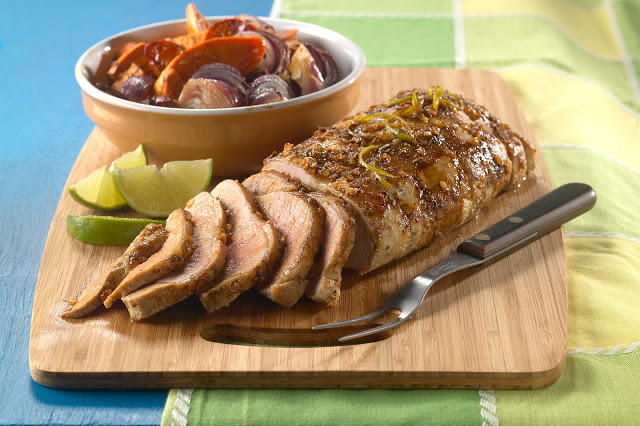
Cuban Glazed Pork Loin Roast.
Pork is Nutrient Dense
The term ‘the other white meat’ makes a lot of sense, as pork is comparable to chicken in it’s fat levels and nutrition. A single serving provides…
- Iron 7%: Getting enough iron is a problem for some women, especially women of child-bearing age. Heme iron (found in meat) is absorbed more readily than non-heme iron (found in plant-based foods). Thus, anyone who avoids meat without the help of their health professional may increase their risk of iron-deficiency anemia.
- Magnesium 6%: Important for the normal function of many enzymes (catalysts for the body’s chemical reactors), glucose and muscle action.
- Phosphorous 22%: Strengthens bones and generates energy in cells.
- Potassium 11%: This mineral, also known as an electrolyte, plays a major role in water balance and helps maintain normal blood pressure.
- Zinc 15%: A component of more than 70 enzymes, zinc is a key player in energy metabolism and the immune system.
- Thiamin 53%: Without this key vitamin, metabolism of carbohydrate, protein and fat would be significantly compromised. Animal protein is one of the best sources of this nutrient, and among the choices, pork is tops.
- Riboflavin 19%: Next to milk, there are few foods that have as much riboflavin per serving as pork. Riboflavin has an important role in the release of energy from foods.
- Niacin 20%: Important for the normal function of many enzymes in the body and involved in the metabolism of sugars and fatty acids.
- Vitamin B12 33%: Helps build red blood cells and metabolize carbohydrates and fats.
- Vitamin B6 (Pyridoxine) 18%: Important for the normal function of enzymes and co-enzymes, which are needed to metabolize protein, carbohydrates and fats. Plus, it plays a critical role in the regulation of glycogen (stored carbohydrates) metabolism.
All pictures and recipes are from http://www.porkbeinspired.com/ – check it out, a great website!
Comments are closed.

